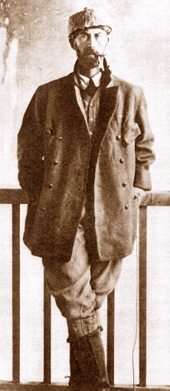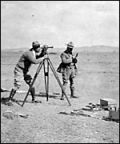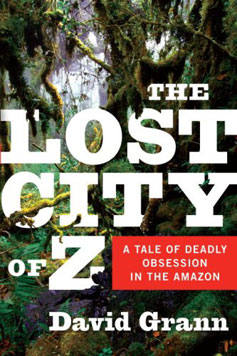Tale of a Lost Explorer and Lost City by Kosmo
The Real Indiana Jones?
From time to time, famous people disappear. Recently, adventurer and aviator Steve Fossett went missing while flying over Nevada and the wreckage of his plane and his remains were later found. In times past, others have vanished: Amelia Earhart, Jimmy Hoffa, Michael Rockefeller and D.B. Cooper. And way back in May 1925 British explorer Colonel Percy Harrison Fawcett disappeared in the wilds of Brazil.
You may ask yourself who in the heck is Colonel Fawcett? Well, now
it's time to find out about this fascinating fellow, who, some think,
may have been the inspiration behind the creation of movie character
Indiana Jones.
Colonel Percy Harrison Fawcett was born in 1867 in Devon, England. Fawcett acquired the military appellation, Colonel, while working in the British armed forces, including service during World War I. Fawcett's first expedition to South America took place in 1906. While working as a surveyor for the Royal Geographic Society, Fawcett mapped an area between Bolivia and Brazil. In the following years, Fawcett developed an interest in the legendary lost cities of South America. In 1920 he visited a library in Rio de Janeiro where he found manuscript No. 512, which showed a record of a Portuguese expedition to the Amazon in 1743. The expedition discovered the ruins of an immense stone city, apparently abandoned and, on some of the stone monuments, hieroglyphs were found resembling Celtic Ogham, an extinct Irish language.
Fawcett surmised that this lost city existed in the Mato Grosso region of Brazil. He figured the city was perhaps 11,000 years old and contained much gold. Perhaps this fabulous place was one of the Sete Cidades (Seven Cities), for which the conquistadors had searched in vain for centuries. Fawcett called the place Z. He hypothesized that Z might be the capital of fabled Atlantis, and/or that it may also have had some connection to the ancient Celts, a fair-skinned, red- or blonde-haired people, the descendants of which Fawcett claimed to have seen during his travels in the area. Fawcett made seven expeditions between 1906 and 1924, exploring mostly the Mato Grosso region of Brazil. But, alas, Fawcett found nary a stone block of his fanciful jungle metropolis.
Colonel Fawcett's son Brian wrote about his father's exploits in the book Lost Trails, Lost Cities, a scrapping good adventure story published in 1953. (Colonel Fawcett's autobiography, titled "Travel and Mystery in South America" was never published and lost while sent to publishers in 1924.) Fawcett's early adventures inspired such writers as Sir Arthur Conan Doyle, who wrote the famous science-fiction novel The Lost World, and H. Rider Haggard, author of She and King Solomon's Mines, among others.
On Fawcett's last journey to the Mato Grosso in the spring of 1925, he brought along his eldest son Jack and Jack's friend Raleigh Rimmell. (T. E. Lawrence -a.k.a. Lawrence of Arabia - wanted to go, but Fawcett said no). The trio was last heard from at what Fawcett called Dead Horse Camp, near the upper Xingu River.
There are plenty of theories regarding Fawcett's fate. He and his companions could have been killed by hostile Indians, perhaps the Kalapalos; they could have starved to death, been killed by wild animals, eaten by cannibals or succumbed to injury and/or disease. Or maybe Fawcett lost his mind and lived the remainder of his life in some peaceful village, fathering children. People claimed to have seen Fawcett or Rimmell many years after their disappearance, though none of those reports were substantiated.
Since Fawcett's vanishing act, 13 expeditions have searched for him,
ending the lives of 100 people. East of Dead Horse Camp in 1932, an
unnamed German man reportedly saw the shrunken head of a white man
resembling Fawcett. In 1933 Fawcett's theodolite was found near the
camp of the Bacaari Indians in the Mato Grosso. Even Fawcett's bones
were supposedly found, but this episode turned out to be a hoax.
In a more speculative vein, Fawcett was a theosophist or mystic, who had studied the teachings of Madame Blavatsky, famous psychic and founder of the Theosophical Society. Fawcett believed his eldest son Jack was a reincarnated spirit destined to become some kind of messiah. Before Jack was born in Ceylon, Buddhists and soothsayers correctly predicted that Jack would be born on the Buddha's anniversary, May 19, 1903, one month later than the expected date of birth. They also predicted that Jack would have a birthmark on his right foot, unusual toes, and that his eyes would have an "obliquity," all of which turned out to be true. (Fawcett wrote about this revelation in an article for the Occult Review.) In Brian Fawcett's co-called Secret Papers, he wrote that his father wanted to deliver his son Jack to the "Earth Guardians" of the Great White Brotherhood (white for purity not race). Some Fawcett enthusiasts think Fawcett found these advanced people and that he now resides in the subterranean city of Ibez, also called Matau-Araacauga, somewhere in the Roncador section of the Mato Grosso.
But others think Fawcett went elsewhere. Reportedly, Fawcett started
off at the city of Cuiabá in Brazil and then traveled northeast toward
the upper Xingu, where he sent his last transmittal to his wife,
telling her essentially not to come looking for him if he didn't
return. In the novel, Indiana Jones and the Seven Veils, Indy
also travels northeast, looking for Z, hoping to find Fawcett too, of
course, between the Xingu and Araguaia Rivers, where a mountain range
supposedly lay. The story takes place in 1926, when the maps of the
area weren't reliable, but the maps of today don't show any mountain
range between those rivers. In this Seven Veils story, the
inhabitants of Z have paranormal powers, with which they "veil" the
mountain range from the view of outsiders, so they can't crash the
party. Naturally, Indy crashes the party, as he always seems to do!
However, in the preface to the play, AmaZonia, based on Brian Fawcett's Secret Papers, the author says that Fawcett trekked northwest
from Cuiabá, but just exactly where in the northwest nobody knows for
certain. Perhaps Fawcett ventured into the Serra do Tombador, a
mountain range northwest of Cuiabá. By all accounts, factual or
fictional, Fawcett disappeared in a mountainous area with a nearby
river. (The Arinos River lies to the east of the Serra do Tombador).
If Colonel Fawcett didn't find immortality or at least an extended life span, then he's as dead as a mahogany table. But maybe his grave could be located - if it's marked in some way. However, locating Colonel Fawcett's final resting place could be as difficult as finding the elusive El Dorado.
Regarding the search for Fawcett's lost city, in 1998 a BBC producer visited a so-called lost city in Colombia, populated by people dressed in white robes who called themselves the Kogi. The Kogi claim to be earth guardians whose purpose is to teach mankind spirituality and how to live harmoniously with nature. This supposed lost city isn't much of a city - lost or otherwise - just a series of large stone platforms, pathways and staircases, and the Kogi have lived by there for many years. At any rate, that's in Colombia. As yet, nobody has found any ancient stone-built cities in Amazonia.
But there's still hope! In the book, Discovering Ruins and Rock Art in Brazil and Peru, the author, G. Cope Schellhorn, wrote about finding the pre-Inca ruins of a stone wall and some kind of ceremonial platform near the Paratoari Pyramids in Amazonian Peru. (These "pyramids" are simply jungle-covered limestone formations that attracted attention in satellite photos taken back in the late 1970s.)
Well, who's ready to launch an expedition to the Mato Grosso? If you can find Colonel Fawcett, his grave or his lost city, you'll be world famous overnight. And the book and movie rights could be worth millions!
In the meantime a new book titled Amazon Adventure (Fiction)
promises to fill the gap. Available later this year the book is written
by Ben Hammott, author of the critically acclaimed non-fiction book Lost Tomb of the Knights Templar. Hammott's
book begins at Dead Horse Camp, Colonel Fawcett's last known position,
and continues to find the Lost City Fawcett was searching for. For more
information visit the excellent Fawcett Adventure website, where you will find advance chapters to read. Also take the time to check out Hammott's Lost Tomb book, you will not regret it.
Here is the book blurb from the offical website:
 Coming in 2010 the new novel that continues Fawcett's quest to find his Lost City of Z
Coming in 2010 the new novel that continues Fawcett's quest to find his Lost City of ZThe date is 1925 - The location is the Amazon Jungle.
Colonel Percy Fawcett, his son Jack and close friend Raleigh Rimmell, are looking for a lost City rumoured to be hidden in the unexplored regions of the cannibal inhabited jungle.
Dead Horse Camp is situated at the boundary of unexplored territory. Ahead lay the unknown, danger, and perhaps a Lost Civilisation.
The three explorers enter the jungle never to be seen or heard from again. Until now!
Present day - New information that reveals what befell the Fawcett expedition reaches the civilised world. A team is put together to travel to the Amazon jungle. Their task is to unravel the mystery and find the Lost City of Z.
But the journey to the Lost City is just the beginning. Inside lurks danger and a secret those guarding it will kill to protect. Survival will not be easy, escape impossible.
Fawcett's adventure continues in AMAZON ADVENTURE Journey to Colonel Fawcett's Lost City
An exciting archaeological mystery thriller with flashbacks to Colonel Fawcett's 1925 Expedition.
In the meantime we have the latest book about Colonel Fawcett to keep us satisfied, itis The Lost City of Z by David Grann ( 2009 )
After stumbling upon a hidden trove of diaries, acclaimed New Yorker writer David Grann set out to solve “the greatest exploration mystery of the twentieth century”: What happened to the British explorer Percy Fawcett and his quest for the Lost City of Z?
On the whole it is recieving favourable reviews so worth checking out. 
Visit Grann's website for more info and excerpts from the book.